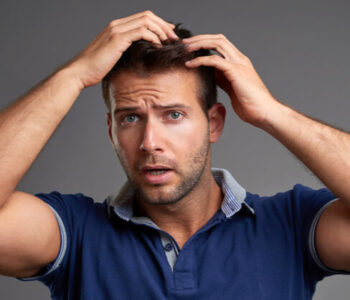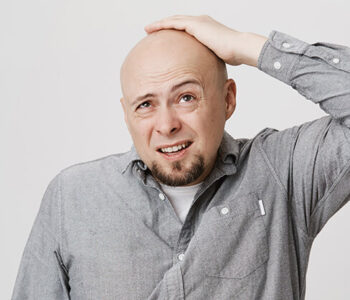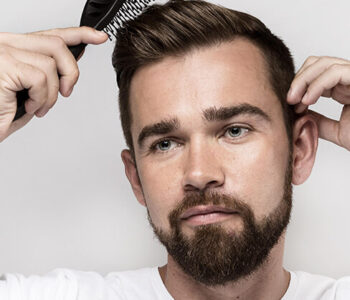In 30 seconds…
There are a number of hair loss treatments and remedies available online. Some are scientifically proven, with verified research backing solid, widespread claims of success. Others, meanwhile, are more than a little questionable.
Hair loss treatments such as Minoxidil and Finasteride fall firmly into the first category, delivering thick, strong, and healthy hair regrowth to countless men around the world.
Home remedies, such as scalp massages, specialist shampoos, vitamins, and onion juice (you read that right) simply pale in comparison.
From tried and tested treatments to questionable lotions, potions, and pills, the internet is awash with hair loss remedies.
And when it comes to combating thinning and bald spots, getting a handle on what works and what doesn’t is crucial. Doing so from the word go will save you from wasting precious time and money pursuing a treatment that, at best, has no scientific track record, and at worst is simply an old wives tale.
In this article, we take a look at the treatments proven to get results, and a few of those hair loss home remedies worth avoiding. But first…
What Are the Common Causes of Hair Loss?
Hair loss in men can be caused by all manner of things. From stress and anxiety, to poor diet, a lack of vitamins, or various medical conditions; it can all result in balding or thinning hair.
But the most common reason for hair loss is frankly inescapable. It’s age. As we get older, hormonal processes develop which ultimately lead to male pattern baldness (MPB). The speed at which we go bald is largely tied to our genetics — but there are a few things we can do to slow hair loss, or stop it altogether. Let’s take a closer look at them.
4 Tried & Tested Hair Loss Treatments
1. Minoxidil
- What is it? Minoxidil is an FDA-approved, over-the-counter topical hair loss treatment. It’s also sold under the brand names “Rogaine” (US) and “Regaine” (UK), and comes in the form of a spray or lotion.
- How does it work? Minoxidil is a vasodilator. This means it improves the health and lifespan of your hair follicles by widening the blood vessels in your scalp, increasing blood flow to the area and bringing all-important nutrients with it. Ultimately, this enhances follicular health and hair density.
- How do you use it? Simply apply the solution to your dry hair and scalp twice daily.
Does Minoxidil Work?
By no means a hair loss cure-all, Minoxidil does boast some promising results:
- One study observed that around 60% of patients saw improved hair coverage after 48 weeks of continual use.
- Another study found that 74% of men considered Minoxidil to have improved hair density after 4 months.
- And research involving 11,000 participants over the course of 12 months resulted in 92% rating the treatment as excellent, good, or fair.
Unfortunately, there’s no guarantee that Minoxidil will work for everyone who tries it, but it’s worth sticking it out as visible results can take around 4 months. If you do experience hair regrowth, chances are it’ll be soft and barely noticeable, to begin with. However, with continued use, the newly sprouted hair should take on the same colour and thickness as the rest.
How Long Do Minoxidil Results Last?
The results of Minoxidil last for as long as you use the topical solution (twice-daily). Once you stop, any regrown hair will be lost within three to four months, and the hair loss process will start anew.
Like the other treatments in this guide, Minoxidil requires a long-term commitment. As yet, there’s no proven permanent hair loss solution; only those which yield results due to ongoing measures.
Are There Side Effects to Minoxidil?
Although safe and simple to use, a very small number of users may encounter mild Minoxidil side-effects. These can include scalp irritation and unwanted hair growth on other parts of the body, while you may also experience dizziness, low blood pressure, and an allergic reaction (although this is rare).
Ironically, one of the best-known side effects of Minoxidil is hair loss. Don’t worry; this is completely normal. Minoxidil kick-starts your hair growth cycle, and shedding is a natural part of it.
You can read more about how Minoxidil works and how to apply it safely in our in-depth guide: Minoxidil 101.
2. Finasteride
- What is it? Finasteride is an oral hair loss treatment. It’s sold under the brand name “Propecia”. It comes in the form of a once-a-day tablet.
- How does it work? Male pattern baldness (MPB) — otherwise known as “androgenic alopecia” or “male pattern hair loss” — is predominantly caused by your hormones. Specifically, a hormone called dihydrotestosterone (DHT), which binds to your hair follicles and causes them to weaken, shrink, and stop producing hair.
Finasteride works by blocking an enzyme called 5-alpha reductase (5AR), which is responsible for converting testosterone into DHT. With less DHT in your system, your follicles are able to recover, producing thicker, stronger hair in the process.
- How do you use it? Take one tablet every day. Easy!
Does Finasteride Work?
Like Minoxidil, research into the efficacy of Finasteride has been encouraging:
- Three five-year studies, involving almost 6,000 patients, found that hair loss was stopped in 90% of men — with 77% enjoying increased hair growth.
- Meanwhile, a 2003 study noted that 83% of participants experienced no further hair loss.
- And a 2012 study observed that 87% experienced greater hair growth thanks to Finasteride.
It can take anywhere from six to nine months to see results with Finasteride. And it’s important to remember that DHT is only blocked so long as Finasteride is active in your system. Once you stop taking it, 5AR is once again able to convert testosterone into DHT, and this will restart your hair loss.
If you stop taking Finasteride altogether, you’ll typically lose the hair you’ve gained within nine to twelve months.
Are There Side Effects to Finasteride?
Finasteride is incredibly safe, with the vast majority of men experiencing no serious side effects.
However, some mild side effects have been observed. You may experience temporary weakness, dizziness, or swelling in the hands or chest. And in very (very) rare cases, sexual side effects can also occur, including erectile dysfunction (ED), lowered libido, and ejaculation disorders.
It’s worth noting that these sexual side effects are primarily associated with higher doses of Finasteride and that a 2019 review of studies found no significant connection between the 1mg dosage of Finasteride for MPB and ED.
Does taking Finasteride make a difference? See for yourself: Finasteride: Before & After.
3. Combination MPB Treatment: Minoxidil + Finasteride
On the face of it, Finasteride and Minoxidil are completely different medications with different goals.
For starters, Finasteride is taken orally and gets to work stopping hair loss at its source by inhibiting DHT production. Meanwhile, Minoxidil is used outside of the body to kickstart the growth cycle, encouraging new and healthy hair growth.
But it’s precisely these differences that make Minoxidil and Finasteride such an effective combo in treating hair loss, receding hairlines, thinning and balding.
And because they work in different ways, targeting different areas of the body, there’s absolutely no risk in taking them at the same time. Take a look at the success Luke had using this combination treatment.
4. Hair Transplant Surgery
Commonly, permanent hair loss presents on the top of the head. To combat this, some men turn to surgery to rescue their cherished locks. So, how does it work?
In short, a hair transplant involves a surgeon removing healthy hair follicles from one part of the head and transplanting them to a bald or thinning spot elsewhere. If done well, it can result in a convincing, natural look.
However, although it sounds simple enough, it’s important to remember that this is a painful and invasive procedure, and that it can take multiple surgeries to achieve the results you want. It also introduces the risk of bruising, bleeding, swelling and infection.
Furthermore, hereditary hair loss will eventually take hold regardless, meaning you’ll almost certainly need to turn to Finasteride and/or Minoxidil to prevent further hair loss post-transplant.
Are There Alternative Hair Loss Treatments?
In addition to the treatments outlined above, you may encounter some natural hair loss remedies as you browse the internet in search of a solution. These run the gamut from the seemingly sensible to the downright bizarre. Let’s explore in a little more detail.
6 Home Remedies for Hair Loss
1. Scalp Massage
There’s nothing to lose with this particular approach. Massaging your scalp won’t cost you a penny, and the only side effect you’ll experience is increased relaxation. Well, that and potential hair growth.
The idea is that when you apply gentle pressure around your scalp after washing your hair, you’ll encourage blood flow to the area. And as we’ve discovered, increased blood flow means more oxygen and nutrients contributing to healthy hair growth.
Does it work? Interestingly, a small 2016 study and a slightly larger 2019 study both reported positive results, so it’s worth a shot.
2. Specialist Shampoo & Conditioner
Another that falls into the “no harm in trying” category, specialist anti-thinning shampoos and conditioners work by providing volume so that your hair appears thicker.
But do they work for hair regrowth? Not necessarily. Many of the leading hair care brands do contain important ingredients and stimulants, like peppermint oil, aloe vera, menthol, or caffeine, but these are geared towards achieving a healthy scalp and removing dandruff, rather than sprouting more hair.
3. Multivitamins
To enjoy a healthy head of hair, you need a healthy body. If you’re not getting the vitamins you need as part of a balanced diet, that could contribute to some degree of hair loss.
A blood test (like one you can get with Manual Wellbeing) is the simplest way of discovering if you’re lacking in certain vitamins, nutrients, and amino acids. If you are, you may be given a specialist treatment or prescribed a daily multivitamin supplement to help get you back on track.
Does it help with hair growth? Healthy hair relies on folic acid, iron, and zinc to keep it strong and thick, so to that end, yes. But that’s only if you’re lacking nutrients. If you’re getting all the vitamins you need and you’re still losing hair, other factors are at play. In other words, more vitamins won’t do the trick.
4. Biotin
A water-soluble nutrient which naturally occurs in foods like nuts and lentils, biotin (or vitamin B-7) helps to break down enzymes in your body. As with multivitamins, if you’re eating a balanced diet, chances are you’re getting all the biotin you need. But that hasn’t stopped biotin growing in popularity as a hair growth and energy supplement.
But does it work? Not on its own. If you’re deficient in vitamin B-7, taking biotin supplements will help, and this may provide your body with the boost it needs to encourage healthy hair growth. But biotin won’t attack the root cause of MPB — your hormones.
5. Essential Oils
Essential oils are derived from plants, such as lavender, tea tree, peppermint, aloe vera, rosemary, and more. They’re typically used in both aromatherapy and dermatology and are also popular in alternative medicine.
Can they help with hair loss? Like many of the remedies on this list, essential oils will probably help improve hair and scalp health, but they stop short of promoting new hair growth.
6. Onion Juice
Now we’re firmly in the territory of “things your grandmother swears by.” Onion juice has, in all seriousness, been suggested as a hair loss solution. Why? Well, the idea goes that the sulfur present in the onion juice can help encourage regrowth and thicker hair.
It doesn’t work, does it? Incredibly, a small 2002 study tested this approach on people with alopecia areata and discovered that those using onion juice experienced more hair growth than those using tap water. However, not all of the participants completed the study, so a pinch of salt is required. Plus, who wants to walk around smelling like onions?
Key Takeaways: Hair Loss Remedies
There are some weird and wonderful natural remedies for hair loss out there, but none come close to the effectiveness of Minoxidil and Finasteride — especially when combined.
If you’re currently dealing with male pattern baldness, or if you’ve noticed things are a little thinner up top of late, chat with one of our accredited clinicians. Manual hair treatment packages can be ordered online and delivered directly to your door in discreet packaging. And there are no onions in sight.












